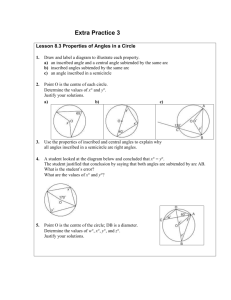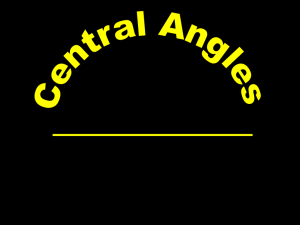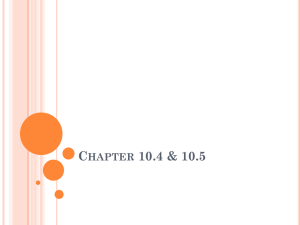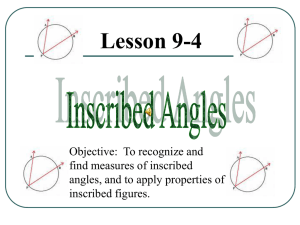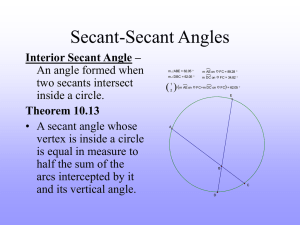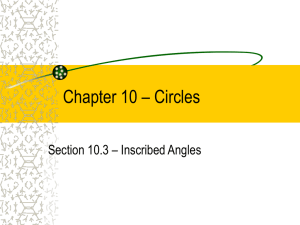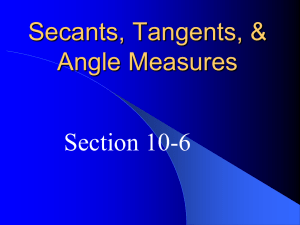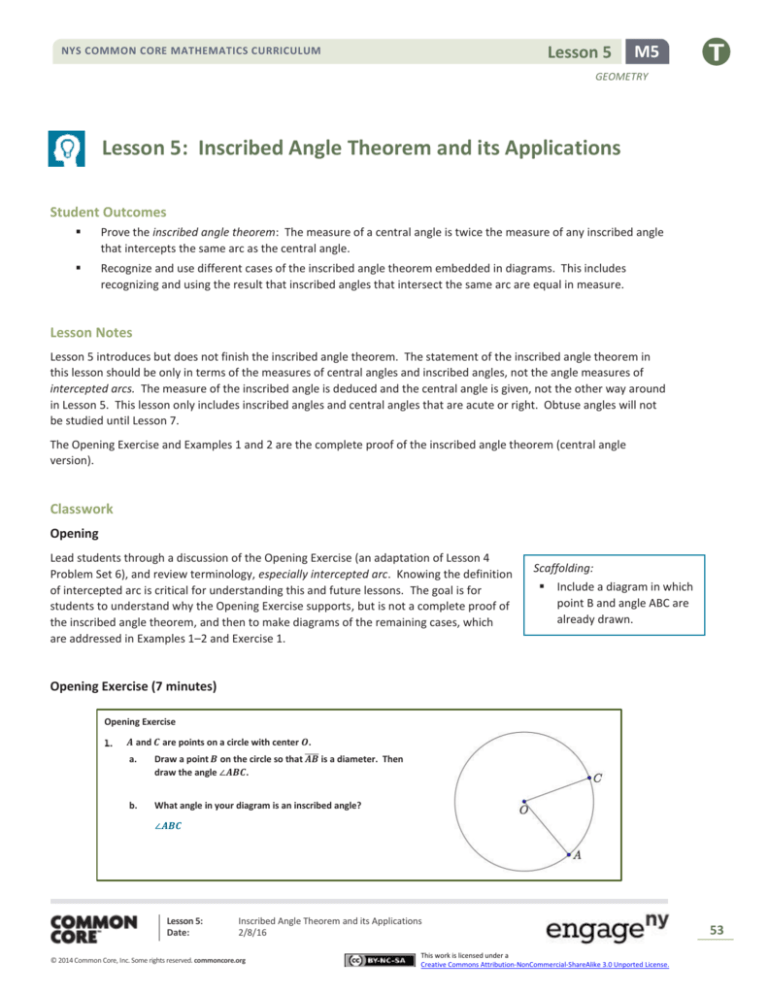
Lesson 5
NYS COMMON CORE MATHEMATICS CURRICULUM
M5
GEOMETRY
Lesson 5: Inscribed Angle Theorem and its Applications
Student Outcomes
Prove the inscribed angle theorem: The measure of a central angle is twice the measure of any inscribed angle
that intercepts the same arc as the central angle.
Recognize and use different cases of the inscribed angle theorem embedded in diagrams. This includes
recognizing and using the result that inscribed angles that intersect the same arc are equal in measure.
Lesson Notes
Lesson 5 introduces but does not finish the inscribed angle theorem. The statement of the inscribed angle theorem in
this lesson should be only in terms of the measures of central angles and inscribed angles, not the angle measures of
intercepted arcs. The measure of the inscribed angle is deduced and the central angle is given, not the other way around
in Lesson 5. This lesson only includes inscribed angles and central angles that are acute or right. Obtuse angles will not
be studied until Lesson 7.
The Opening Exercise and Examples 1 and 2 are the complete proof of the inscribed angle theorem (central angle
version).
Classwork
Opening
Lead students through a discussion of the Opening Exercise (an adaptation of Lesson 4
Problem Set 6), and review terminology, especially intercepted arc. Knowing the definition
of intercepted arc is critical for understanding this and future lessons. The goal is for
students to understand why the Opening Exercise supports, but is not a complete proof of
the inscribed angle theorem, and then to make diagrams of the remaining cases, which
are addressed in Examples 1–2 and Exercise 1.
Scaffolding:
Include a diagram in which
point B and angle ABC are
already drawn.
Opening Exercise (7 minutes)
Opening Exercise
𝑨 and 𝑪 are points on a circle with center 𝑶.
a.
Draw a point 𝑩 on the circle so that ̅̅̅̅
𝑨𝑩 is a diameter. Then
draw the angle ∠𝑨𝑩𝑪.
b.
What angle in your diagram is an inscribed angle?
∠𝑨𝑩𝑪
Lesson 5:
Date:
Inscribed Angle Theorem and its Applications
2/8/16
© 2014 Common Core, Inc. Some rights reserved. commoncore.org
This work is licensed under a
Creative Commons Attribution-NonCommercial-ShareAlike 3.0 Unported License.
53
Lesson 5
NYS COMMON CORE MATHEMATICS CURRICULUM
M5
GEOMETRY
c.
What angle in your diagram is a central angle?
∠𝑨𝑶𝑪
d.
What is the intercepted arc of angle ∠𝑨𝑩𝑪?
̂
Minor arc 𝑨𝑪
e.
What is the intercepted arc of ∠𝑨𝑶𝑪 ?
̂
Minor arc 𝑨𝑪
2. The measure of the inscribed angle is 𝒙 and the measure of the
central angle is 𝒚. Find 𝒎∠𝑪𝑨𝑩 in terms of 𝒙?
We are given 𝒎∠𝑫 = 𝒙, and we know that 𝑨𝑩 = 𝑨𝑪 = 𝑨𝑫, so
∆𝑪𝑨𝑫 is an isosceles triangle, meaning 𝒎∠𝑨𝑪𝑫 is also 𝒙. The sum
of the angles of a triangle is 𝟏𝟖𝟎, so 𝒎∠𝑪𝑨𝑫 = 𝟏𝟖𝟎 − 𝟐𝒙. ∠𝑪𝑨𝑫
and ∠𝑪𝑨𝑩 are supplementary meaning that
𝒎∠𝑪𝑨𝑩 = 𝟏𝟖𝟎 – (𝟏𝟖𝟎 – 𝟐𝒙) = 𝟐𝒙; therefore, 𝒚 = 𝟐𝒙.
Relevant Vocabulary
INSCRIBED ANGLE THEOREM (as it will be stated in Lesson 7): The measure of an inscribed angle is half the angle measure of
its intercepted arc.
INSCRIBED ANGLE: An inscribed angle is an angle whose vertex is on a circle, and each side of the angle intersects the circle
in another point.
ARC INTERCEPTED BY AN ANGLE: An angle intercepts an arc if the endpoints of the arc lie on the angle, all other points of the
arc are in the interior of the angle, and each side of the angle contains an endpoint of the arc. An angle inscribed in a
circle intercepts exactly one arc; in particular, the arc intercepted by a right angle is the semicircle in the interior of the
angle.
Exploratory Challenge (10 minutes)
Review the definition of intercepted arc, inscribed angle, and central angle and then state the inscribed angle theorem.
Then highlight the fact that we have proved one case but not all cases of the inscribed angle theorem (the case in which
a side of the angle passes through the center of the circle). Sketch drawings of various cases to set up; for instance,
Example 1 could be the inside case and Example 2 could be the outside case. You may want to sketch them in a place
where you can refer to them throughout the class.
Scaffolding:
Post drawings of each case
as they are studied in the
class as well as the
definitions of inscribed
angles, central angles, and
intercepted arcs.
Lesson 5:
Date:
Inscribed Angle Theorem and its Applications
2/8/16
© 2014 Common Core, Inc. Some rights reserved. commoncore.org
This work is licensed under a
Creative Commons Attribution-NonCommercial-ShareAlike 3.0 Unported License.
54
Lesson 5
NYS COMMON CORE MATHEMATICS CURRICULUM
M5
GEOMETRY
MP.7
What do you notice that is the same or different about each of these pictures?
Answers will vary.
What arc is intercepted by ∠𝐴𝐵𝐶?
̂
The minor arc 𝐴𝐶
How do you know this arc is intercepted by ∠𝐴𝐵𝐶?
The endpoints of the arc (𝐴 and 𝐶) lie on the angle.
All other points of the arc are inside the angle.
Each side of the angle contains one endpoint of the arc.
THEOREM: The measure of a central angle is twice the measure of any inscribed angle that intercepts the same
arc as the central angle.
Today we’re going to talk about the inscribed angle theorem. It says the following: The measure of a central
angle is twice the measure of any inscribed angle that intercepts the same arc as the central angle. Does the
Opening Exercise satisfy the conditions of the inscribed angle theorem?
What did we show about the inscribed angle and central angle with the same intersected arc in the Opening
Exercise?
That the measure of ∠𝐴𝑂𝐶 is twice the measure of ∠𝐴𝐵𝐶.
This is because △ 𝑂𝐵𝐶 is an isosceles triangle whose legs are radii. The base angles satisfy
𝑚∠𝐵 = 𝑚∠𝐶 = 𝑥. So, 𝑦 = 2𝑥 because the exterior angle of a triangle is equal to the sum of the
measures of the opposite interior angles.
Does the conclusion of the Opening Exercise match the conclusion of the inscribed angle theorem?
Yes.
Does this mean we have proven the inscribed angle theorem?
Yes. ∠𝐴𝐵𝐶 is an inscribed angle and ∠𝐴𝑂𝐶 is a central angle both of which intercept the same arc.
No. The conditions of the inscribed angle theorem say that ∠𝐴𝐵𝐶 could be any inscribed angle. The
vertex of the angle could be elsewhere on the circle.
How else could the diagram look?
Students may say that diagram could have the center of the circle be inside, outside, or on the inscribed
angle. The Opening Exercise only shows the case when the center is on the inscribed angle. (Discuss
with students that the precise way to say “inside the angle” is to say “in the interior of the angle.”)
We still need to show the cases when the center is inside and outside the inscribed angle.
Lesson 5:
Date:
Inscribed Angle Theorem and its Applications
2/8/16
© 2014 Common Core, Inc. Some rights reserved. commoncore.org
This work is licensed under a
Creative Commons Attribution-NonCommercial-ShareAlike 3.0 Unported License.
55
Lesson 5
NYS COMMON CORE MATHEMATICS CURRICULUM
M5
GEOMETRY
There is one more case, when 𝐵 is on the minor arc between 𝐴 and 𝐶 instead of the major arc.
If students ask where the 𝑥 and 𝑦 are in this diagram, say we’ll find out in Lesson 7.
Scaffolding:
Examples 1–2 (10 minutes)
These examples prove the second and third case scenarios – the case when the center of
the circle is inside or outside the inscribed angle and the inscribed angle is acute. Both use
similar computations based on the Opening Exercise. Example 1 is easier to see than
Example 2. For Example 2, you may want to let students figure out the diagram on their
own, but then go through the proof as a class.
Go over proofs of Examples 1–2 with the case when angle ∠𝐴𝐵𝐶 is acute. If a student
draws 𝐵 so that angle ∠𝐴𝐵𝐶 is obtuse, save the diagram for later when doing Lesson 7.
Note that the diagrams for the Opening Exercise as well as Examples 1–2 have been
labeled so that in each diagram, 𝑂 is the center, ∠𝐴𝐵𝐶 is an inscribed angle, and ∠𝐴𝑂𝐶 is
a central angle. This consistency highlights parallels between the computations in the
three cases.
Before doing Examples 1
and 2, or instead of going
through the examples,
teachers could do an
exploratory activity using
the triangles shown in
Exercise 3 parts (a), (b),
and (c). Have students
measure the central and
inscribed angles,
intercepting the same arc
with a protractor, then log
the measurements in a
table, and look for a
pattern.
Example 1
𝑨 and 𝑪 are points on a circle with center 𝑶.
a.
What is the intercepted arc of ∠𝑪𝑶𝑨? Color it red.
̂
Minor arc 𝑨𝑪
b.
Draw triangle 𝑨𝑶𝑪. What type of triangle is it? Why?
An isosceles triangle because 𝑶𝑪 = 𝑶𝑨 (they are radii of the same circle).
Lesson 5:
Date:
Inscribed Angle Theorem and its Applications
2/8/16
© 2014 Common Core, Inc. Some rights reserved. commoncore.org
This work is licensed under a
Creative Commons Attribution-NonCommercial-ShareAlike 3.0 Unported License.
56
Lesson 5
NYS COMMON CORE MATHEMATICS CURRICULUM
M5
GEOMETRY
c.
What can you conclude about 𝒎∠𝑶𝑪𝑨 and 𝒎∠𝑶𝑨𝑪? Why?
They are equal because base angles of an isosceles triangle are equal in measure.
d.
Draw a point 𝑩 on the circle so that 𝑶 is in the interior of the inscribed angle ∠𝑨𝑩𝑪.
The diagram should resemble the inside case of the discussion diagrams.
e.
What is the intercepted arc of angle ∠𝑨𝑩𝑪? Color it green.
̂
Minor arc 𝑨𝑪
f.
̂?
What do you notice about arc 𝑨𝑪
It is the same arc that was intercepted by the central angle.
g.
Let the measure of ∠𝑨𝑩𝑪 be 𝒙 and the measure of ∠𝑨𝑶𝑪 be 𝒚. Can you
prove that 𝒚 = 𝟐𝒙? (Hint: Draw the diameter that contains point 𝑩.)
̅̅̅̅̅ be a diameter. Let 𝒙𝟏 , 𝒚𝟏 , 𝒙𝟐 , and 𝒚𝟐 be the measures of
Let 𝑩𝑫
∠𝑪𝑩𝑫, ∠𝑪𝑶𝑫, ∠𝑨𝑩𝑫, and ∠𝑨𝑶𝑫, respectively. We can express 𝒙 and 𝒚
in terms of these measures: 𝒙 = 𝒙𝟏 + 𝒙𝟐 , and 𝒚 = 𝒚𝟏 + 𝒚𝟐 . By the
opening exercise,
𝒚𝟏 = 𝟐𝒙𝟏 and 𝒚𝟐 = 𝟐𝒙𝟐. Thus 𝒚 = 𝟐𝒙.
h.
Does your conclusion support the inscribed angle theorem?
Yes, even when the center of the circle is in the interior of the inscribed angle, the measure of the inscribed
angle is equal to half the measure of the central angle that intercepts the same arc.
i.
If we combine the Opening Exercise and this proof, have we finished proving the inscribed angle theorem?
No. We still have to prove the case where the center is outside the inscribed angle.
Example 2
𝑨 and 𝑪 are points on a circle with center 𝑶.
a.
Draw a point 𝑩 on the circle so that 𝑶 is in the exterior of the inscribed angle ∠𝑨𝑩𝑪.
The diagram should resemble the outside case of the discussion diagrams.
Lesson 5:
Date:
Inscribed Angle Theorem and its Applications
2/8/16
© 2014 Common Core, Inc. Some rights reserved. commoncore.org
This work is licensed under a
Creative Commons Attribution-NonCommercial-ShareAlike 3.0 Unported License.
57
Lesson 5
NYS COMMON CORE MATHEMATICS CURRICULUM
M5
GEOMETRY
b.
What is the intercepted arc of angle ∠𝑨𝑩𝑪? Color it yellow.
̂
Minor arc 𝑨𝑪
c.
Let the measure of ∠𝑨𝑩𝑪 be 𝒙, and the measure of ∠𝑨𝑶𝑪 be 𝒚. Can
you prove that 𝒚 = 𝟐𝒙? (Hint: Draw the diameter that contains
point 𝑩.)
̅̅̅̅̅ be a diameter. Let 𝒙𝟏 , 𝒚𝟏 , 𝒙𝟐 , and 𝒚𝟐 be the measures of
Let 𝑩𝑫
∠𝑪𝑩𝑫, ∠𝑪𝑶𝑫, ∠𝑨𝑩𝑫, and ∠𝑨𝑶𝑫, respectively. We can express 𝒙 and
𝒚 in terms of these measures:
𝒙 = 𝒙𝟐 − 𝒙𝟏 and 𝒚 = 𝒚𝟐 − 𝒚𝟏 By the Opening Exercise, 𝒚𝟏 = 𝟐𝒙𝟏 and
𝒚𝟐 = 𝟐𝒙𝟐. Thus, 𝒚 = 𝟐𝒙.
d.
Does your conclusion support the inscribed angle theorem?
Yes, even when the center of the circle is in the exterior of the inscribed angle, the measure of the inscribed
angle is equal to half the measure of the central angle that intercepts the same arc.
e.
Have we finished proving the inscribed angle theorem?
We have shown all cases of the inscribed angle theorem (central angle version). We do have one more case
to study in Lesson 7, but it is ok not to mention it here. The last case is when the location of 𝑩 is on the minor
arc between 𝑨 and 𝑪.
Ask students to summarize the results of these theorems to each other before moving on.
Exercises 1–5 (10 minutes)
Exercises are listed in order of complexity. Students do not have to do all problems. Problems can be specifically
assigned to students based on ability.
Exercises 1–5
Find the measure of the angle with measure 𝒙.
a.
𝒎∠𝑫 = 𝟐𝟓°
b.
𝒎∠𝑫 = 𝟏𝟓°
c.
𝒎∠𝑩𝑨𝑪 = 𝟗𝟎°
𝒙
𝒙
𝒙
𝒙
𝟓𝟎°
Lesson 5:
Date:
𝟏𝟓𝟎°
𝟒𝟓°
Inscribed Angle Theorem and its Applications
2/8/16
© 2014 Common Core, Inc. Some rights reserved. commoncore.org
This work is licensed under a
Creative Commons Attribution-NonCommercial-ShareAlike 3.0 Unported License.
58
Lesson 5
NYS COMMON CORE MATHEMATICS CURRICULUM
M5
GEOMETRY
d.
𝒎∠𝑩 = 𝟑𝟐°
e.
𝟓𝟖°
f.
𝒎∠𝑫 = 𝟏𝟗°
𝟕𝟏°
𝒙 = 𝒘 = 𝟔𝟎°
Toby says ∆𝑩𝑬𝑨 is a right triangle because 𝒎∠𝑩𝑬𝑨 = 𝟗𝟎°. Is he correct? Justify your answer.
Toby is not correct. The 𝒎∠𝑩𝑬𝑨 = 𝟗𝟓°. ∠𝑩𝑪𝑫 is inscribed in the same
arc as the central angle, so it has a measure of 𝟑𝟓°. This means that
𝒎∠𝑫𝑬𝑪 = 𝟗𝟓° because the sum of the angles of a triangle is 𝟏𝟖𝟎°.
𝒎∠𝑩𝑬𝑨 = 𝒎∠𝑫𝑬𝑪 since they are vertical angles, so the triangle is not
right.
Let’s look at relationships between inscribed angles.
a.
Examine the inscribed polygon below. Express 𝒙 in terms of 𝒚 and 𝒚 in terms of 𝒙. Are the opposite angles in
any quadrilateral inscribed in a circle supplementary? Explain.
𝒙 = 𝟏𝟖𝟎° − 𝒚; 𝒚 = 𝟏𝟖𝟎° − 𝒙. The angles are supplementary.
b.
Examine the diagram below. How many angles have the same
measure, and what are their measures in terms of 𝒙?
Let 𝑪 and 𝑫 be the points on the circle that the original angles
contain. All the angles intercepting the minor arc between 𝑪
and 𝑫 have measure 𝒙, and the angles intercepting the major
arc between 𝑪 and 𝑫 measure 𝟏𝟖𝟎° − 𝒙.
Lesson 5:
Date:
Inscribed Angle Theorem and its Applications
2/8/16
© 2014 Common Core, Inc. Some rights reserved. commoncore.org
This work is licensed under a
Creative Commons Attribution-NonCommercial-ShareAlike 3.0 Unported License.
59
Lesson 5
NYS COMMON CORE MATHEMATICS CURRICULUM
M5
GEOMETRY
Find the measures of the labeled angles.
a.
b.
𝒙 = 𝟐𝟖, 𝒚 = 𝟓𝟎
c.
𝒚 = 𝟒𝟖
d.
𝒙 = 𝟑𝟐
e.
𝒙 = 𝟑𝟔, 𝒚 = 𝟏𝟐𝟎
f.
𝒙 = 𝟒𝟎
Lesson 5:
Date:
𝒙 = 𝟑𝟎
Inscribed Angle Theorem and its Applications
2/8/16
© 2014 Common Core, Inc. Some rights reserved. commoncore.org
This work is licensed under a
Creative Commons Attribution-NonCommercial-ShareAlike 3.0 Unported License.
60
Lesson 5
NYS COMMON CORE MATHEMATICS CURRICULUM
M5
GEOMETRY
Closing (3 minutes)
With a partner, do a 30-second Quick Write of everything that we learned today about the inscribed angle
theorem.
Today we began by revisiting the Problem Set from yesterday as the key to the proof of a new theorem,
the inscribed angle theorem. The practice we had with different cases of the proof allowed us to
recognize the many ways that the inscribed angle theorem can show up in unknown angle problems.
We then solved some unknown angle problems using the inscribed angle theorem combined with other
facts we knew before.
Have students add the theorems in the Lesson Summary to their graphic organizer on circles started in
Lesson 2 with corresponding diagrams.
Lesson Summary
THEOREMS:
THE INSCRIBED ANGLE THEOREM: The measure of a central angle is twice the measure of any inscribed angle
that intercepts the same arc as the central angle.
CONSEQUENCE OF INSCRIBED ANGLE THEOREM: Inscribed angles that intercept the same arc are equal in
measure.
Relevant Vocabulary
INSCRIBED ANGLE: An inscribed angle is an angle whose vertex is on a circle, and each side of
the angle intersects the circle in another point.
INTERCEPTED ARC: An angle intercepts an arc if the endpoints of the arc lie on the angle, all
other points of the arc are in the interior of the angle, and each side of the angle contains
an endpoint of the arc. An angle inscribed in a circle intercepts exactly one arc; in
particular, the arc intercepted by a right angle is the semicircle in the interior of the angle.
Exit Ticket (5 minutes)
Lesson 5:
Date:
Inscribed Angle Theorem and its Applications
2/8/16
© 2014 Common Core, Inc. Some rights reserved. commoncore.org
This work is licensed under a
Creative Commons Attribution-NonCommercial-ShareAlike 3.0 Unported License.
61
Lesson 5
NYS COMMON CORE MATHEMATICS CURRICULUM
M5
GEOMETRY
Name
Date
Lesson 5: Inscribed Angle Theorem and its Application
Exit Ticket
The center of the circle below is 𝑂. If angle 𝐵 has a measure of 15 degrees, find the values of 𝑥 and 𝑦. Explain how you
know.
Lesson 5:
Date:
Inscribed Angle Theorem and its Applications
2/8/16
© 2014 Common Core, Inc. Some rights reserved. commoncore.org
This work is licensed under a
Creative Commons Attribution-NonCommercial-ShareAlike 3.0 Unported License.
62
Lesson 5
NYS COMMON CORE MATHEMATICS CURRICULUM
M5
GEOMETRY
Exit Ticket Sample Solutions
The center of the circle below is 𝑶. If angle 𝑩 has a measure of 𝟏𝟓 degrees, find the values of 𝒙 and 𝒚. Explain how you
know.
𝒚 = 𝟏𝟓. Triangle 𝑪𝑶𝑩 is isosceles, so base angles ∠𝑶𝑪𝑩 and ∠𝑶𝑩𝑪 are congruent. 𝒎∠𝑶𝑩𝑪 = 𝟏𝟓 = 𝒎∠𝑶𝑪𝑩.
𝒙 = 𝟑𝟎. ∠𝑪𝑶𝑨 is a central angle inscribed in the same arc as inscribed angle ∠𝑪𝑩𝑨. So 𝒎∠𝑪𝑶𝑨 = 𝟐𝒎∠𝑪𝑩𝑨.
Problem Set Sample Solutions
Problems 1–2 are intended to strengthen students’ understanding of the proof of the inscribed angle theorem. The
other problems are applications of the inscribed angle theorem. Problems 3–5 are the most straightforward of these,
followed by Problem 6, then Problems 7–9, which combine use of the inscribed angle theorem with facts about triangles,
angles, and polygons. Finally, Problem 10 combines all the above with the use of auxiliary lines in its proof.
Find the value of 𝒙 in each exercise.
𝒙 = 𝟗𝟒
𝒙 = 𝟑𝟒
Lesson 5:
Date:
Inscribed Angle Theorem and its Applications
2/8/16
© 2014 Common Core, Inc. Some rights reserved. commoncore.org
This work is licensed under a
Creative Commons Attribution-NonCommercial-ShareAlike 3.0 Unported License.
63
Lesson 5
NYS COMMON CORE MATHEMATICS CURRICULUM
M5
GEOMETRY
𝒙 = 𝟕𝟎
𝒙 = 𝟑𝟎
𝒙 = 𝟔𝟎
𝒙 = 𝟔𝟎
𝒙 = 𝟐𝟎
Lesson 5:
Date:
𝒙 = 𝟒𝟔
Inscribed Angle Theorem and its Applications
2/8/16
© 2014 Common Core, Inc. Some rights reserved. commoncore.org
This work is licensed under a
Creative Commons Attribution-NonCommercial-ShareAlike 3.0 Unported License.
64
Lesson 5
NYS COMMON CORE MATHEMATICS CURRICULUM
M5
GEOMETRY
9.
a.
The two circles shown intersect at 𝑬 and 𝑭. The center of the larger circle, 𝑫, lies on the circumference of the
̅̅̅̅, cuts the smaller circle at 𝑯, find 𝒙 and 𝒚.
smaller circle. If a chord of the larger circle, 𝑭𝑮
𝒙 = 𝟏𝟎𝟎; 𝒚 = 𝟓𝟎
b.
How does this problem confirm the inscribed angle theorem?
∠𝑭𝑫𝑬 is a central angle of the larger circle and is double ∠𝑭𝑮𝑬, the inscribed angle of the larger circle.
∠𝑭𝑫𝑬 is inscribed in the smaller circle and equal in measure to ∠𝑭𝑯𝑬, also inscribed in the smaller circle.
̅̅̅̅ intersect at point 𝑬.
̅̅̅̅ and 𝑩𝑪
10. In the figure below, 𝑬𝑫
Prove: 𝒎∠𝑫𝑨𝑩 + 𝒎∠𝑬𝑨𝑪 = 𝟐(𝒎∠𝑩𝑭𝑫)
PROOF:
̅̅̅̅.
Join 𝑩𝑬
𝟏
𝟐
𝒎∠𝑩𝑬𝑫 = (𝒎∠___________)
𝟏
𝟐
𝒎∠𝑬𝑩𝑪 = (𝒎∠___________)
In △ 𝑬𝑩𝑭,
𝒎∠𝑩𝑬𝑭 + 𝒎∠𝑬𝑩𝑭 = 𝒎∠___________
𝟏
𝟐
(𝒎∠___________) +
𝟏
𝟐
(𝒎∠___________) = 𝒎∠___________
∴ 𝒎∠𝑫𝑨𝑩 + 𝒎∠𝑬𝑨𝑪 = 𝟐(𝒎∠𝑩𝑭𝑫)
𝑩𝑨𝑫; 𝑬𝑨𝑪; 𝑩𝑭𝑫; 𝑫𝑨𝑩, 𝑬𝑨𝑪, 𝑩𝑭𝑫
Lesson 5:
Date:
Inscribed Angle Theorem and its Applications
2/8/16
© 2014 Common Core, Inc. Some rights reserved. commoncore.org
This work is licensed under a
Creative Commons Attribution-NonCommercial-ShareAlike 3.0 Unported License.
65


